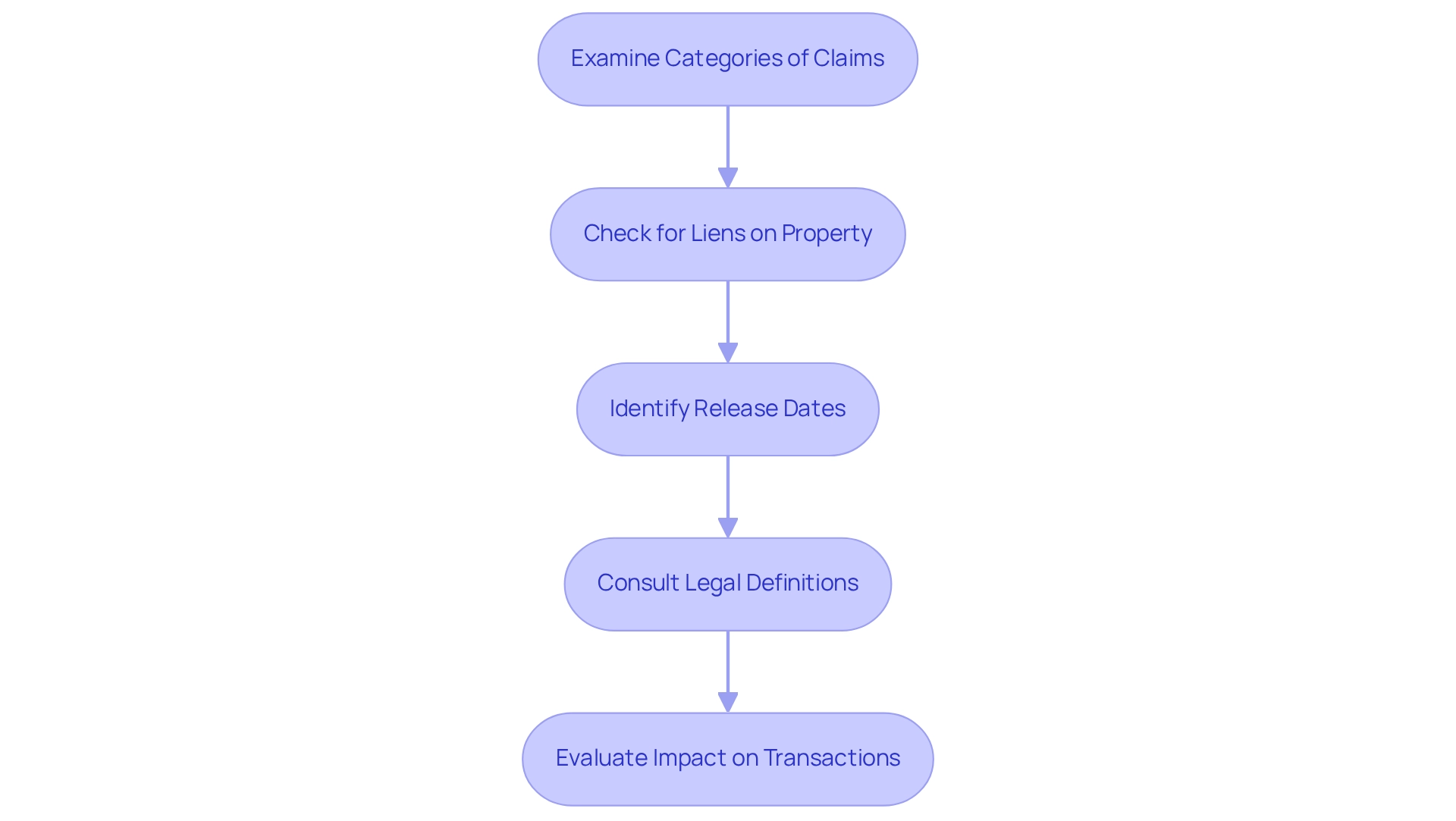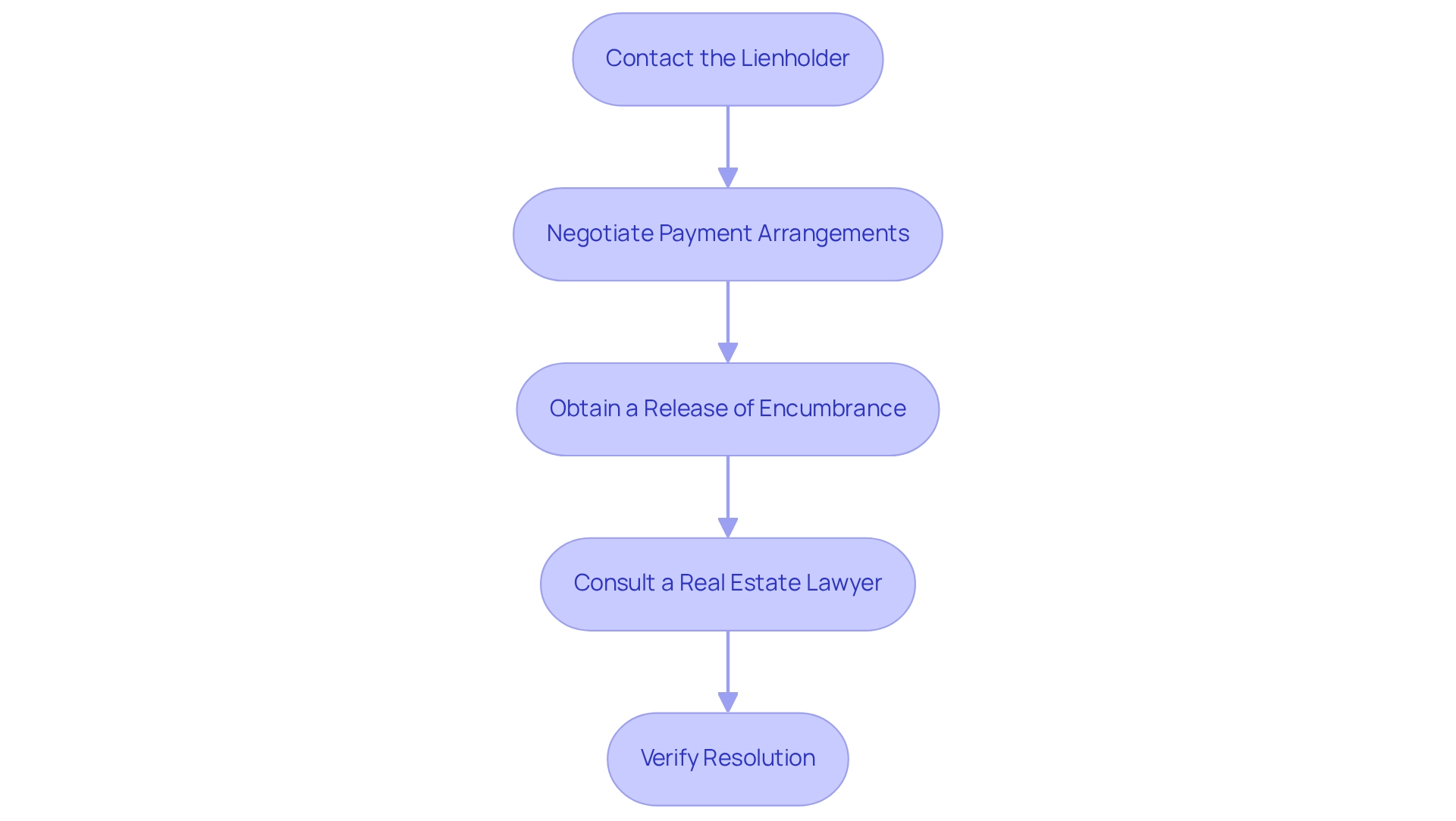Overview
To ascertain the presence of liens on a property, one must employ a systematic approach that encompasses:
- Gathering property details
- Utilizing online county resources
- Effectively interpreting the search results
This article delineates specific steps, including:
- The examination of local databases
- Direct communication with lienholders
It underscores the critical importance of comprehending the various types of claims and their implications for property transactions, thereby enhancing the reader's understanding and facilitating informed decision-making.
Introduction
Navigating the world of property ownership is a complex endeavor, particularly when understanding the implications of property liens. These legal claims can significantly impact real estate transactions, whether one is buying, selling, or refinancing a property.
From mortgage liens that secure loans to tax liens imposed by government entities, the types of liens vary, and each carries its own set of consequences. As the real estate landscape continues to evolve, leveraging innovative technologies—such as those offered by Parse AI—can streamline the process of identifying and resolving these encumbrances.
This article delves into the intricacies of property liens, guiding readers through the essential steps to uncover, interpret, and address any liens that may affect their real estate decisions.
Understand Property Liens and Their Implications
A real estate claim represents a legal assertion against a real estate asset, primarily used to secure payment for a debt. Understanding the various categories of claims is essential:
- Mortgage Claims: These voluntary encumbrances are established by lenders when financing a real estate asset. It is imperative to know how to find out if there are liens on a property, as claims such as tax liens imposed by government entities for unpaid real estate taxes or judgment claims from court rulings against an asset owner can complicate asset transactions. Furthermore, with Parse AI's innovative platform, real estate professionals can efficiently review title records and understand how to find out if there are liens on a property, ensuring a smoother transaction process. By leveraging advanced technologies and collaborating with industry experts, Parse AI is committed to enhancing the title industry and delivering substantial value to its users.

Utilize Online Resources for Lien Searches
To understand how to find out if there are liens on a property, follow these steps:
- Identify the Asset: Gather essential details such as the asset address, owner’s name, and parcel number.
- Visit County Recorder's Website: Most counties maintain online databases where you can look up real estate records. Look for sections labeled 'Land Records' or 'Property Records'. Make use of the advanced digital interface available for Comanche County, which features a query bar and a comprehensive table of records, simplifying navigation.
- To determine how to find out if there are liens on a property, input the property details into the inquiry tool. The platform facilitates comprehensive text inquiries, allowing you to discover claims that might not be indexed in the conventional manner. Review the results to determine how to find out if there are liens on a property.
- Check State Resources: Some states keep centralized databases for tax claims and other encumbrances. Websites like the Department of Revenue can provide additional information.
- Utilize External Services: Consider employing services that focus on property investigations for a thorough report, particularly if the property has a complicated history. Parse AI's automated document processing can enhance this inquiry by efficiently extracting relevant information from documents.

Interpret Lien Search Results Effectively
Upon obtaining the lien search results, it is crucial to know how to find out if there are liens on a property accurately. Begin by examining the categories of claims. Distinguish between voluntary claims, such as mortgages, and involuntary claims, like tax claims; this distinction significantly influences resolution strategies. Next, check how to find out if there are liens on a property for each claim. Understanding how to find out if there are liens on a property is vital for grasping the financial obligations linked to the property.
Furthermore, look for release dates. Identifying any claims that have been released or satisfied indicates that the associated debts have been settled, which is a positive sign. If you encounter unfamiliar terms, consult legal definitions. Utilize legal glossaries or seek clarification from a real estate attorney to ensure accurate understanding. Finally, evaluate how to find out if there are liens on a property and how these claims affect your ability to buy or sell the real estate. Unresolved tax claims, for instance, can hinder a sale, making it essential to assess their potential impact carefully.

Resolve Issues Related to Discovered Liens
If you encounter claims on a property, consider how to find out if there are liens on a property as one of the effective steps to address them.
-
Contact the Lienholder: Reach out to the creditor or organization that imposed the claim. Discuss the outstanding financial obligation and explore potential payment options.
-
Negotiate Payment Arrangements: If the obligation is substantial, negotiate a payment plan that allows you to resolve the claim over time. Utilizing Parse AI's specialized services in negotiation and acquisition of leases and easements can significantly streamline this process.
-
Obtain a Release of Encumbrance: Once the debt is settled, request a formal release document from the holder to ensure the encumbrance is removed from public records.
-
Consult a Real Estate Lawyer: If the claim is complex or contested, seek legal advice to navigate the resolution process effectively. Engaging with title curative services can also help ensure a clean chain of title.
-
Verify Resolution: After resolving the lien, conduct another lien search to confirm that the lien has been officially removed from the property records. Parse AI's GIS modeling services can assist in ensuring accurate leasing and title verification.

Conclusion
Understanding property liens and their implications is crucial for anyone involved in real estate transactions. Mortgage liens secure loans, while tax liens can jeopardize property ownership. Being aware of the types of liens and their consequences can prevent complications down the line. Utilizing online resources and technology, such as Parse AI, simplifies the process of identifying and interpreting these liens, ensuring a smoother transaction experience.
Once liens are identified, effectively interpreting the results is essential. Recognizing the nature of the liens, their amounts, and whether they have been resolved significantly impacts decisions related to buying or selling a property. In cases where liens are discovered, taking proactive steps to negotiate resolutions and obtain releases is vital. Engaging with professionals and utilizing specialized services streamlines this process, ensuring property ownership remains secure and unencumbered.
Ultimately, navigating the complexities of property liens requires diligence and informed action. By leveraging available resources and technologies, property owners and buyers can confidently address any liens that may affect their real estate decisions. Staying informed and proactive safeguards investments and enhances the overall real estate experience.
Frequently Asked Questions
What is a real estate claim?
A real estate claim is a legal assertion against a real estate asset, primarily used to secure payment for a debt.
What are mortgage claims?
Mortgage claims are voluntary encumbrances established by lenders when financing a real estate asset.
Why is it important to know about liens on a property?
It is important to know about liens on a property because claims such as tax liens or judgment claims can complicate asset transactions.
How can real estate professionals find out if there are liens on a property?
Real estate professionals can efficiently review title records and find out if there are liens on a property using Parse AI's innovative platform.
What role does Parse AI play in the title industry?
Parse AI enhances the title industry by leveraging advanced technologies and collaborating with industry experts to deliver substantial value to its users.




